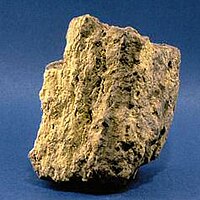
Photo from wikipedia
Abstract As a typical tungsten deposit of the Xitian ore field (Nanling Range, South China), the Xiangdong deposit is a quartz vein-type W deposit related to a Triassic-Jurassic granitic complex,… Click to show full abstract
Abstract As a typical tungsten deposit of the Xitian ore field (Nanling Range, South China), the Xiangdong deposit is a quartz vein-type W deposit related to a Triassic-Jurassic granitic complex, with total ore reserves of ∼7 Mt (WO3 > 30 Kt). In this study, zircon CL and BSE imaging, LA-(MC)-ICP-MS U–Pb dating, trace element, and Hf isotopic analyses were carried out on the fluid-altered granites and related W ores in the Xiangdong deposits, aiming to reveal the genesis of the deposit. Zircon U–Pb dating yielded three age clusters: pre-Triassic (>250 Ma) (n = 19), Triassic (227–214 Ma, or “∼220 Ma”) (n = 111), and Jurassic (159–149 Ma, or “∼150 Ma”) (n = 27). Zircon morphology and geochemistry suggest that Triassic granites and Jurassic quartz veins experienced stronger influences from high-temperature hydrothermal fluids than other geological bodies in the deposit. High contents of P, Y, Pb and U are found in Triassic granite zircons, whereas high concentrations of Nb and Ta occur in Jurassic quartz-vein zircons, indicating different hydrothermal fluid systems during the Triassic and Jurassic. The Triassic and Jurassic zircons yield high Y/Ho ratios (up to 35), representing fractionated non-chondritic compositions, which are indicative of a late-stage residual melt that co-existed with F-rich fluids. Decreases in zircon Ce/Ce* and Eu/Eu* ratios from the Triassic to the Jurassic suggest a decline in fO2 that is likely to have facilitated large-scale Jurassic W mineralization. High 176Yb/177Hf and 176Lu/177Hf ratios in the hydrothermally altered Jurassic zircons indicate intense fluid exsolution from the source magma, whereas the more variable 176Hf/177Hf ratios and Hf model ages of the Triassic zircons suggest multiple fluid sources and more complex alteration processes. A new ore genesis model is proposed for the Xiangdong W deposit: initial enrichment of ore materials during the Late Triassic followed by large-scale tungsten precipitation during the Late Jurassic. The Triassic granite provided the initial W source, whereas granite-derived fluids successively formed magma-differentiated ore veins and infilling-metasomatic ore veins during the Jurassic.
Journal Title: Ore Geology Reviews
Year Published: 2019
Link to full text (if available)
Share on Social Media: Sign Up to like & get
recommendations!